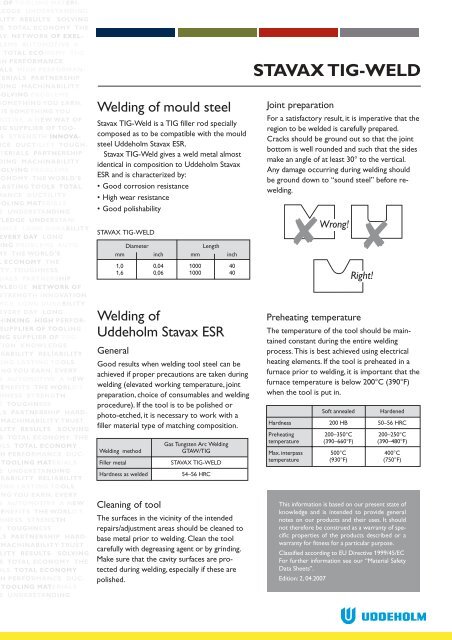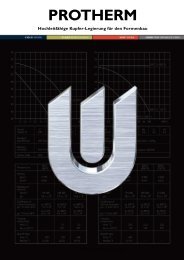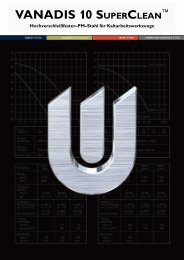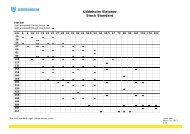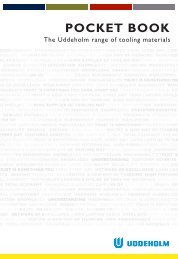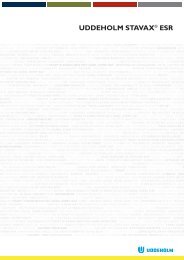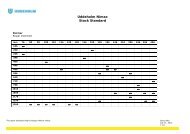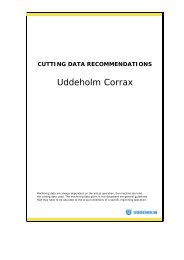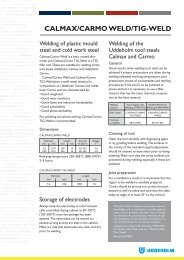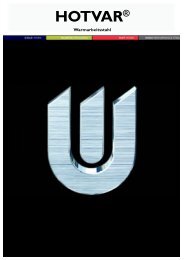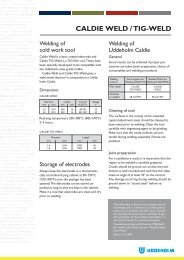Create successful ePaper yourself
Turn your PDF publications into a flip-book with our unique Google optimized e-Paper software.
STAVAX <strong>TIG</strong>-WELD<br />
<strong>Weld</strong>ing of mould steel<br />
<strong>Stavax</strong> <strong>TIG</strong>-<strong>Weld</strong> is a <strong>TIG</strong> filler rod specially<br />
composed as to be compatible with the mould<br />
steel <strong>Uddeholm</strong> <strong>Stavax</strong> ESR.<br />
<strong>Stavax</strong> <strong>TIG</strong>-<strong>Weld</strong> gives a weld metal almost<br />
identical in composition to <strong>Uddeholm</strong> <strong>Stavax</strong><br />
ESR and is characterized by:<br />
•Good corrosion resistance<br />
• High wear resistance<br />
•Good polishability<br />
STAVAX <strong>TIG</strong>-WELD<br />
Diameter<br />
L<strong>eng</strong>th<br />
mm inch mm inch<br />
1,0 0,04 1000 40<br />
1,6 0,06 1000 40<br />
Joint preparation<br />
For a satisfactory result, it is imperative that the<br />
region to be welded is carefully prepared.<br />
Cracks should be ground out so that the joint<br />
bottom is well rounded and such that the sides<br />
make an angle of at least 30° to the vertical.<br />
Any damage occurring during welding should<br />
be ground down to “sound steel” before rewelding.<br />
✘<br />
Wrong!<br />
Right!<br />
✘<br />
<strong>Weld</strong>ing of<br />
<strong>Uddeholm</strong> <strong>Stavax</strong> ESR<br />
General<br />
Good results when welding tool steel can be<br />
achieved if proper precautions are taken during<br />
welding (elevated working temperature, joint<br />
preparation, choice of consumables and welding<br />
procedure). If the tool is to be polished or<br />
photo-etched, it is necessary to work with a<br />
filler material type of matching composition.<br />
<strong>Weld</strong>ing method<br />
Filler metal<br />
Hardness as welded<br />
Gas Tungsten Arc <strong>Weld</strong>ing<br />
GTAW/<strong>TIG</strong><br />
STAVAX <strong>TIG</strong>-WELD<br />
54–56 HRC<br />
Preheating temperature<br />
The temperature of the tool should be maintained<br />
constant during the entire welding<br />
process. This is best achieved using electrical<br />
heating elements. If the tool is preheated in a<br />
furnace prior to welding, it is important that the<br />
furnace temperature is below 200°C (390°F)<br />
when the tool is put in.<br />
Soft annealed Hardened<br />
Hardness 200 HB 50–56 HRC<br />
Preheating 200–350°C 200–250°C<br />
temperature (390–660°F) (390–480°F)<br />
Max. interpass 500°C 400°C<br />
temperature (930°F) (750°F)<br />
Cleaning of tool<br />
The surfaces in the vicinity of the intended<br />
repairs/adjustment areas should be cleaned to<br />
base metal prior to welding. Clean the tool<br />
carefully with degreasing agent or by grinding.<br />
Make sure that the cavity surfaces are protected<br />
during welding, especially if these are<br />
polished.<br />
This information is based on our present state of<br />
knowledge and is intended to provide general<br />
notes on our products and their uses. It should<br />
not therefore be construed as a warranty of specific<br />
properties of the products described or a<br />
warranty for fitness for a particular purpose.<br />
Classified according to EU Directive 1999/45/EC<br />
For further information see our “Material Safety<br />
Data Sheets”.<br />
Edition: 2, 04.2007
HAGFORS KLARTEXT U<strong>070406</strong>.500 / TRYCKERI KNAPPEN, KARLSTAD 200704128<br />
Building up the weld<br />
The root runs should be done with low heat<br />
input (max. current 120 A).<br />
The first two layers should always be welded<br />
with the same low heat input, while a greater<br />
heat input can be used for the remaining layers.<br />
At least two runs (even for small repairs) are<br />
recommended. Do not oscillate.<br />
The transition region between the weld and<br />
the base material should be carefully inspected<br />
prior to stopping welding. Undercut should be<br />
repaired before further processing.<br />
After welding the final layer of weld metal<br />
should be ground away prior to any heat<br />
treatment.<br />
If the tool is to be polished or photo-etched<br />
<strong>TIG</strong> welding is to be preferred.<br />
For more detailed information, see the<br />
<strong>Uddeholm</strong> brochure “<strong>Weld</strong>ing of Tool Steel”.<br />
Post treatment<br />
Condition Soft annealed Hardened<br />
Hardness 200 HB 50–56 HRC<br />
Cooling rate 20–40°C/h (35–70°F/h) for the<br />
first 2 hours then freely in air<br />
Heat treatment Soft anneal Temper 10–20°C<br />
TEMPERING GRAPH FOR THE WELD METAL<br />
Hardness after welding 54–56 HRC.<br />
Hardness, HRC<br />
65<br />
60<br />
55<br />
Harden<br />
Temper<br />
(20–35°F) below<br />
the highest previous<br />
tempering<br />
temperature<br />
50<br />
45<br />
40<br />
35<br />
30<br />
Soft annealed/<br />
hardened/tempered<br />
Tempered<br />
100 200 300 400 500 600°C<br />
210 390 570 750 930 1110°F<br />
Holding time 2 x 1h<br />
<strong>Stavax</strong> <strong>TIG</strong>-<strong>Weld</strong> and Impax <strong>TIG</strong>-<strong>Weld</strong> are <strong>TIG</strong> filler<br />
rods specially composed as to be compatible with the<br />
mould steels <strong>Uddeholm</strong> <strong>Stavax</strong> ESR and <strong>Uddeholm</strong><br />
Impax Supreme. This gives a perfect result after polishing<br />
or photo-etching of the welded tool.<br />
FURTHER INFORMATION<br />
Please contact your local <strong>Uddeholm</strong> office for further information on the selection, heat treatment, application and<br />
availability of <strong>Uddeholm</strong> tool steels. For more information, please visit www.uddeholm.com or www.assab.com


